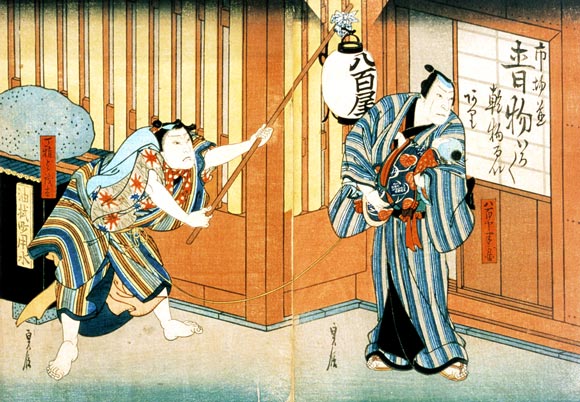| YAOYA NO KONDATE |
| Play title | Sewa Ryôri Yaoya Kondate |
| Authors | Ki-no-Kaion ("Shinjû Futatsu Haraobi") Chikamatsu Monzaemon ("Shinjû Yoi Gôshin") Namiki Gohei I ("Sewa Ryôri Yaoya Kondate") |
| History |
"Yaoya no Kondate" was based on the real story of the greengrocer Hanbę and his wife Ochiyo, who committed their shinjû in Ôsaka the 3rd (or the 5th day?) of the 4th lunar month of 1722 [1] on the eve of the Kôshin festival. There was a great stir in Ôsaka because of this sad event and the playwright Ki-no-Kaion immediately adapted it to the puppet theater. His play was entitled "Shinjû Futatsu Haraobi" and it was staged from the 6th of 4th lunar month of 1722 [2] at the Toyotakeza. Ki-no-Kaion's rival Chikamatsu Monzaemon wrote his own version, which was entitled "Shinjû Yoi Gôshin" and was staged from the 22nd of the 4th lunar month of 1722 [3] at the Takemotoza. The first Kabuki adapatations were produced at the end of the 4th lunar month of 1722 in Kyôto and in the 8th lunar month of 1722 in Edo. The play in Kyôto was entitled "Yaoya Shinjû" and the roles of Ochiyo and Hanbę were played by Segawa Kikunojô I and Iwai Hanshirô III. The play in Edo was entitled "Hana Môsen Futatsu Haraobi" and the roles of Ochiyo and Hanbę were played by Arashi Wakano I and Nakamura Shichisaburô II. The story of Hanbę and Ochiyo was sad and dark and the role of Hanbę's step-mother Okuma was the one of an evil old woman. In 1788, Namiki Gohei I wrote a new version of the story of Ochiyo and Hanbę and decided to turn Okuma into a comical role, performed by a sanmaime. This drama was entitled "Sewa Ryôri Yaoya Kondate" and was staged in the 3rd lunar month of 1788 in Ôsaka at the Kado no Shibai [more details]. Later on, it was revised by Ichioka Washichi I. Nowadays, this play is rarely staged. |
| Structure |
"Yaoya no Kondate" is made up of one act. |
| Key words | Sewamono Shinjûmono Ochiyo-hanbęmono |
| Summary |
Tarobę, a friend of the late father of Hanbę, a greengrocer, comes to Hanbę's house with Hanbę's wife Ochiyo, who has been expelled by Hanbę's step-mother Okuma, to ask her to re-accept Ochiyo. Strange to say, Okuma welcomes her back, lavishing flattery on her. Before taking Tarobę to another room to offer him a supper, however, she warns Hanbę in a low voice never to forget what she has told him to do. Unaware of Okuma's remark, Ochiyo says to Hanbę that she is very glad to be reunited with him. Hanbę's elder brother Jûzô, a samurai, who happens to be visiting the house, tells Hanbę never to divorce Ochiyo. Hanbę agrees, but when Okuma comes again to tell him that she has a sharpened kitchen knife in case he does not obey him, he sternly tells Ochiyo that he divorces her. Jûzô scolds Hanbę and beats him with a fan. Okuma, showing her true colors, tells Hanbę not to listen to Jûzô and beats Hanbę and Ochiyo with a broom. Hanbę's late father's nephew Kajûrô comes out of an inner room and, taking the broom from Okuma, beats her with it. He says Okuma was picked up as a beggar by Hanbę's late father, who was then a widower, and, while working as a maid servant for him, seduced him to become his second wife. Furious with rage, Okuma leaves the room but she has yet another scheme to have her own way. She reappears in her undergarment, carrying a straw mat on her back and holding a rice bowl and chopsticks in her hands. She says she will go begging, telling people all over Ôsaka that she was driven from her home by her heartless step-son. Hanbę is thus forced to write a letter of divorce. Jûzô proposes to take Ochiyo with him. Before leaving, he hands his sword to Hanbę, tacitly advising him to commit suicide in token of apology to his late father and Ochiyo's parents. After Ochiyo and Jûzô have gone, Okuma begins to make amicable advances to Hanbę but is interrupted when Santarô, an apprentice, comes to tell her that Tarobę is calling her. Left alone, Hanbę tries to kill himself when Ochiyo returns home to tell him that she will die together with him. Okuma comes back in a night gown, carrying a pillow and a quiet, to ask Hanbę to sleep with her. Tarobę blows out the light to help clamber and Ochiyo slip out of the house. Okuma catches hold of Tarobę in the dark, taking him for Hanbę. Text written by Hironaga Shûzaburô |
| Notes |
[1] The 5th day of the 4th lunar month of the 7th year of the Kyôhô era was the 19th of May 1722 in the western calendar. [2] The 6th day of the 4th lunar month of the 7th year of the Kyôhô era was the 20th of May 1722 in the western calendar. [3] The 22nd day of the 4th lunar month of the 7th year of the Kyôhô era was the 5th of June 1722 in the western calendar. |
 |
|
The actors Onoe Tamizô II and Jitsukawa Enzaburô I playing the roles of the decchi Yomota and Hanbę in the drama "Sewa Ryôri Yaoya Kondate", which was staged in the 9th lunar month of 1849 at the Kado no Shibai (print made by Hasegawa Sadanobu I) |
|
|
| Contact | Main | Top | Updates | Actors | Plays | Playwrights | Programs | Links | FAQ | Glossary | Chronology | Illustrations | Prints | Characters | Derivatives | Theaters | Coming soon | News |